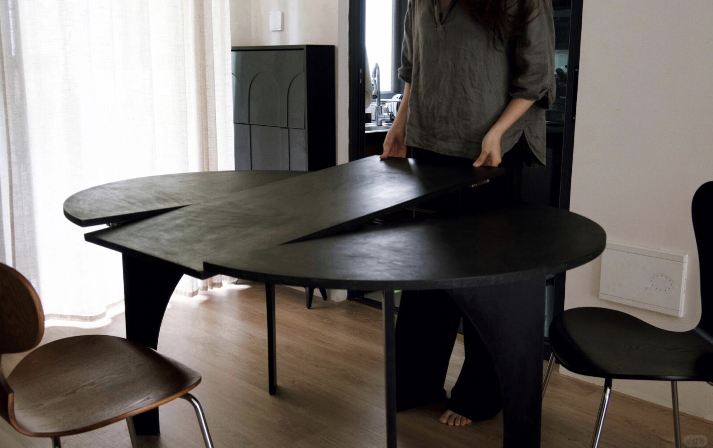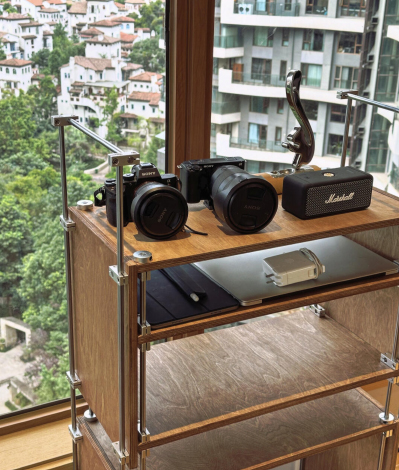| China |
| The growing trend of DIY furniture among youth in China | |
|
|
 Zhang Baibai showcases her DIY extendable dining table in Guangzhou, Guangdong Province on August 12, 2024 (SCREENSHOT)
Through two relocations since moving to Guangzhou—capital of Guangdong Province in south China—Zhang Baibai has curated an entire home's worth of furniture, each piece handcrafted by her. She and her husband arrived in the city in 2022 as renters, later purchasing their own apartment. Initially driven by necessity, Zhang turned to furniture-making as a thrift measure. "We were saving for our home and refused to sink money into temporary furnishings," she told Guangzhou's Yangcheng Evening News. But how to economize while cultivating a truly livable space? The solution came when she stumbled upon online DIY furniture tutorials. Inspired, she bought some Paulownia wood boards, which, prized for being lightweight and affordable, are perfect for solo projects. She also learned wood painting to finish the pieces. "Most of the furniture I made has a simple structure," Zhang said. "It mainly involves buying boards, painting them, and assembling. But despite the simplicity, the quality makes them surprisingly durable." One of her earliest creations was a coat rack. The materials were basic: a wood board, some small wooden rods, and pebbles she brought from her hometown. "I painted the board, drilled holes, screwed in the rods, and glued the pebbles to their ends with no-nail adhesive," she said. Her most ambitious project was a sofa, inspired by finding a beautiful wooden frame online. "I bought it immediately and started customizing it," she said. After purchasing fabric and padding, she hand-stitched the sofa cover and cushions at home. Remarkably, most of Zhang's DIY furniture remains in excellent condition today. "Even if any part eventually breaks, I'll instantly know what's gone wrong and how to fix it—because I built it myself," she said.  A creator on RedNote shows off a DIY storage shelf made from marine plywood on November 14, 2024 (SCREENSHOT)
Design and assembly Searches for terms like "marine plywood," "linear shaft," and "aluminum profiles" on Xiaohongshu (RedNote), China's leading lifestyle and e-commerce platform, reveal a thriving world of DIY furniture innovation. Unlike traditional woodworking—which demands expertise in sawing, polishing and other complex joinery—creating furniture with linear shafts and aluminum profiles requires minimal specialized skills. Users can craft bookshelves from marine plywood, build walk-in closets with aluminum profiles, and even transform linear shafts into lamp stands. The possibility of creative applications with these materials inspires many people, who are eager to try their own projects. A Shanghai-based architect surnamed Guo, who labels himself a DIY enthusiast, frequently shares his furniture-making experiences on RedNote. His latest project: a mid-century modern cabinet crafted from two sheets of marine plywood using traditional Chinese mortise-and-tenon joinery—no nails or glue. He documents the process in videos, including his mistakes, and discusses with followers the lessons learned. He also offers paid design blueprints for DIY beginners. "DIY home renovation and furniture-making, even creating design drawings or renderings, aren't difficult. It's less complicated than it seems, just apply some effort," he said in his videos. Yet some users find the process challenging. A Hangzhou-based netizen surnamed Lin, after attempting a shoe rack with marine plywood and aluminum profiles, described it as extremely time-consuming and laborious. "Many mainly showcase finished pieces, making DIY seem effortless," Lin said in one of the videos he uploaded on RedNote. "But the reality hits hard. Marine plywood's back-straining heft, endless screws to wrestle, and steps that stubbornly tangle transform the seemly simple work into raw labor." Lin found a supportive community of creators on the platform, who used self-deprecating humor when sharing their DIY fails, building each other's confidence in the process. Some call imperfections as signatures of the craft, as these pieces proudly bear their "experimental" spirit. They think that an open display of structural elements, such as unsealed plywood seams, visible aluminum brackets, protruding linear shaft nuts and naked sliding rails, transform industrial practicality into art. For Bella (pseudonym), DIY is about enjoying the process, rather than striving for perfection. Assembling custom-cut templates with aluminum profiles in the evenings is fun for her. "It's like adult Lego; but crafting functional, eco-friendly furniture delivers a reward no toy can match—the satisfaction of creation," she told the New Weekly magazine. Beijing-based Wang Xiaochen also views DIY furniture as "adult-scale toys." "Growing up in an era of scarcity, the toys my father and grandfather handmade became our most treasured comforts," the 30-something told newspaper Beijing Daily. Last year, when his daughter was born, he built her crib from scratch. "Seeing her lying there, fluttering her eyes and giggling, I realized the crib had transformed from solitary craft into our bridge of connection," he said, his voice softening. "It cradles her dreams." Necessity to comfort For Zhang Baibai, these handcrafted pieces now transcend mere functionality. After moving out of her first apartment in Guangzhou, Zhang brought all her DIY furniture to her new home. "When moving to a new place, I initially feel a bit unfamiliar with the surroundings. But with these self-made furniture pieces keeping me company, I quickly grew accustomed to my new home," she said. The new apartment was slightly larger than her previous one and the old furniture she brought wasn't enough to fill it, so she crafted a new batch of DIY pieces. This time, the motivation was more about passion than necessity. She even taught herself computer aided design software, designing blueprints that she sent directly to manufacturers. The factories would cut the wooden boards according to her designs, and she'd assemble them herself. Nearly everything visible upon entering her home is handmade by her and her husband, including a bookshelf, an extendable dining table, a vanity mirror stand, jewelry storage boxes, and a coffee table. To make more than a dozen furniture items, she used just five wooden boards, costing around 5,000 yuan ($700). These handcrafted pieces serve as living archives of her life—each bearing witness to her evolving tastes, from her retro-inspired phase to her minimalist era. The collaborative building process with her husband forged deeper bonds between them. "Though my home lies far from work—over an hour's commute each way—returning here each day brings profound comfort," she said. "Every piece we built together transforms this space into a sanctuary." Copyedited by G.P. Wilson Comments to yuanyuan@cicgamericas.com |
|
||||||||||||||||||||||||||||
|